After a complete hearing evaluation has been completed, the physician may recommend to the patient that hearing aids would enhance the patient’s quality of life. The patient would then meet with one of our highly trained audiologists. Our audiologists are skilled at determining the type of hearing aid best suited for the patient’s hearing loss. They strive to help each patient achieve the best results possible with the technology they choose, taking into consideration the degree of hearing loss, the ear or ears affected, the style of hearing aid used for that particular loss, the technology of the device, and its overall cost.
At Midwest Ear, Nose & Throat Hearing Center in Sioux Falls, our audiologists work with a number of hearing aid manufacturers to make certain that the most appropriate aid is selected. We offer special hearing center promotions from time to time. See our event schedule for dates and details.
Purchasing a Hearing Aid
How do hearing aids work?
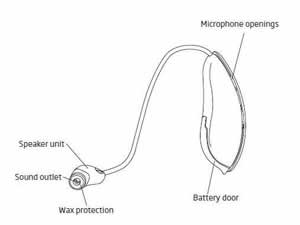 A hearing instrument consists of a microphone, an amplifier or processor and a speaker, which transmits the enhanced sound waves into your ear. A tiny battery supplies the necessary power. Modern hearing instruments are tailored to suit the ear shape, degree of hearing loss, lifestyle and listening habits of each individual user.
A hearing instrument consists of a microphone, an amplifier or processor and a speaker, which transmits the enhanced sound waves into your ear. A tiny battery supplies the necessary power. Modern hearing instruments are tailored to suit the ear shape, degree of hearing loss, lifestyle and listening habits of each individual user.
Modern hearing instruments are also equipped with directional microphones, meaning that what you are looking at is also what you hear best. In other words, you decide what you want to listen to at any given time, especially in conversations with several people.
For more information about our services, call 888-336-3503 or 605-275-1205.
What type of instrument is right for me?

There are several types of hearing aids. Each type offers different advantages, depending on its design, levels of amplification and size. Hearing Centers of the Midwest, LLC allows patients to try out different styles when they purchase to make sure they will have the most comfortable fit and what will work best for their needs.
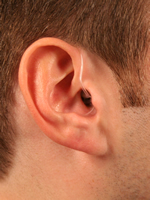 Receiver In The Ear (RITE) or Receiver In Canal (RIC) Hearing Aid
Receiver In The Ear (RITE) or Receiver In Canal (RIC) Hearing Aid
Comfortable open fit, sleek design barely visible when worn, color choices to match your hair, skin tone and lifestyle, For mild to moderate hearing loss, switches modes seamlessly to match your listening environment. Improved speech understanding with the industry’s top-rated feedback canceller
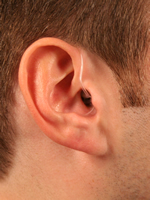 Mini Receiver In The Ear (RITE) or Receiver In Canal (RIC) Hearing Aid
Mini Receiver In The Ear (RITE) or Receiver In Canal (RIC) Hearing Aid
Mini RITE is extremely popular because of its tiny size.
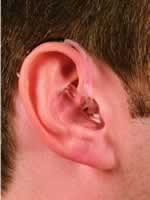 Behind The Ear (BTE) Hearing Aid
Behind The Ear (BTE) Hearing Aid
Easiest to adjust, appropriate for most types of hearing loss, color choices to match your hair, skin tone and lifestyle. Offers greater amplification compared to smaller, in-the-ear instruments. Available as an Open Fit Solution for the most comfortable fit. Switches modes seamlessly to match your listening environment. Improved speech understanding with the industry’s top-rated feedback canceller
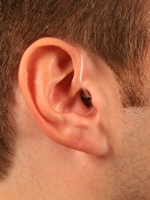 Mini Behind The Ear (BTE) Hearing Aid
Mini Behind The Ear (BTE) Hearing Aid
Smallest BTE model available, with thin tubing and a tiny earbud for ultimate discretion. Appropriate for most types of hearing loss and ages
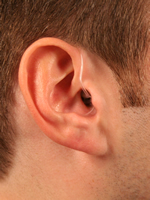 Over The Ear (OTE) Hearing Aid
Over The Ear (OTE) Hearing Aid
This style is similar in appearance to a BTE but on a much smaller scale. This type of aid usually delivers sound to the ear via a tiny translucent tube and earbud. It is designed to keep the ear canal open so that natural sounds can enter your ear in addition to the amplified sound.
 In The Ear (ITE) Hearing Aid
In The Ear (ITE) Hearing Aid
Easy to adjust, ideal for those with limited manual dexterity. Appropriate for mild to mildly severe hearing loss. Custom made just for you.
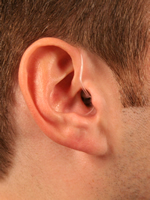 In The Canal (ITC) or Half Shell (HS) Hearing Aid
In The Canal (ITC) or Half Shell (HS) Hearing Aid
Appropriate for mild to mildly severe hearing loss. Variety of technology level choices that previously required a larger aid. Custom made just for you.
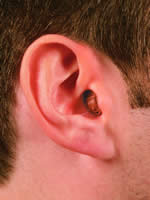 Completely In Canal (CIC) Hearing Aid
Completely In Canal (CIC) Hearing Aid
Fits completely in the ear canal and is virtually invisible, Appropriate for mild to mildly severe hearing loss. Custom made just for you. Requires some manual dexterity.
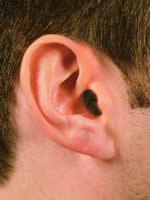 Invisible In Canal (IIC) Hearing Aid
Invisible In Canal (IIC) Hearing Aid
• 100% invisible when worn
• Designed to be removed daily to promote better ear health
• No whistling or buzzing
• Natural sounding
• Designed custom for your ear
• Works great on the phone
• Appropriate for a range of hearing losses
For more information about our services, call 888-336-3503 or 605-275-1205.
How much do hearing aids cost and is financial aid available?
We offer a wide selection of models to meet any budget. A new digital style hearing instrument can range from $1,000 – $4,000 depending on a person’s hearing needs, lifestyle needs, and the device’s level of technology. To see which model would be best for your needs and how much they would cost, one of our specialists will need to evaluate and assess your hearing. Call 605-275-1205 or 888-336-3503 today to set up a free evaluation!
Some health insurance policies cover hearing devices. We are a registered provider of Wellmark Blue Cross/Blue Shield. You can bring your information in to us and we will call to see if your particular coverage includes hearing instruments. We work with SD Medicaid which covers certain instruments. Children may be covered by their state’s early intervention program or State Children’s Health Insurance Program (SCHIP). Indian Health Services also provides coverage. The Starkey Hear Now Program is wonderful for those with low income. Please contact our office to see if you qualify. We also work with Care Credit to get affordable payments for every budget. You can apply through our office or follow the instructions below to apply on your own.
- Go to www.carecredit.com
- Fill out the patient application
- Receive a decision immediately
- Contact our practice to schedule treatment
Automated Phone Application
- Call 1-800-365-8295 and follow the prompts
- Receive an immediate decision
- Contact our practice to schedule treatment
For more information about our services, call 888-336-3503 or 605-275-1205.
How do I care for my hearing aids?
 Daily care and attention will prolong the life of your hearing investment.
Daily care and attention will prolong the life of your hearing investment.- Wipe daily with a soft, lint free cloth. Be sure to clean the receiver and vent openings with the proper cleaning tool; see your hearing professional for the proper tool and use.
- Turn off when not in use overnight. Be sure to leave the battery door open to allow any accumulated moisture to dry. It is best to store the instruments in the holder your specialist provided at delivery. Also, keep the battery compartment clean and dry.
- Do not store the hearing instruments with the battery installed for an extended length of time. Remove the battery and store your hearing instruments in a cool dry place.
- Remove hearing instruments before using hair spray.
- Do not expose your hearing instruments to excessive moisture, humidity or steam.
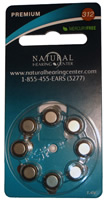 Do not wear your hearing instruments while bathing, showering or swimming.
Do not wear your hearing instruments while bathing, showering or swimming.- Keep away from heat sources such as stoves, heat registers, hair dryers and open flame.
- Do not drop your hearing instruments or allow them to be subjected to rough handling.
- Keep away from pets, dogs in particular are aroused by feedback sounds sometimes produced by hearing instruments when not being worn.
- Keep fresh batteries in your hearing instruments and be aware that your hearing aid will stop functioning when the battery dies. This is of particular importance as you drive in traffic or are in other situations where you may rely on warning sounds for safety.
- Keep in touch – we encourage you to maintain regular contact with us. A regularly scheduled check of your instruments will enhance long-lasting reliability of your new hearing instrument(s). Yearly testing of your hearing is also crucial to assure that the products you purchased are delivering the performance needed to match any changing hearing conditions.
For more information about our services, call 888-336-3503 or 605-275-1205.
How can I troubleshooting a hearing aid problem?
Use this guide to help solve some of the common problems patients may experience with a hearing aid. If you have a problem not defined or one that persists, call us right away.
- No Sound from Hearing Aid
- Battery may be dead or in backwards
- Check to see instrument is on
- Sound outlet may be plugged with wax
- Weak Sounding Hearing Aid
- Weak battery
- Sound outlet may be plugged with wax
- Your hearing condition may have changed
- Mic inlet plugged with wax
- Crackling/Frying Sounding Hearing Aid
- Weak battery
- Wax problem
- Whistling Sound from Hearing Aid
- Volume control is too high or there is excessive wax buildup in your ear
- An object, such as a coat collar, hat or scarf may be covering the sound inlet
If you are still having difficulties don't hesitate to give us a call. 605-275-1205 or Toll Free 1-888-336-3503
Common hearing aid myths and facts
Myth: They make me look older
Fact: What price are you paying for vanity? Untreated hearing loss is far more noticeable than a hearing aid. If you miss a punch line to a joke or respond inappropriately in conversation, people may have concerns about your mental acuity, your attention span, or your ability to communicate effectively. The personal consequences of vanity can be life altering. At a simplistic level, untreated hearing loss means giving up some of the pleasant sounds you used to enjoy. At a deeper level, vanity could severely reduce the quality of your life.
Myth: Hearing aids are for old people
Fact: People with hearing loss often seem less confident in conversations and may tend to withdraw or be slower on the uptake. Hearing better will help you feel more confident, and others will notice that you are more involved. Not only do they look great, but these high technology devices allow you to participate fully in conversations, and your life.
Myth: I’m too old to benefit from hearing aids.
Fact: You are never too old to receive help in hearing. As you get older, spending more time with your family and friends should be more important, not fall to the wayside. It is a proven fact that being close to loved ones is one of the main factors in how long a person lives.
Myth: They’re too expensive.
Fact: They’re an investment in your life. For many, the improved quality of life and relationships make hearing devices one of the best investments they ever made. According to Dr. Sergei Kochkin of the Better Hearing Institute, wearing hearing instruments can increase your salary by up to $12,000. Dr. Kochkin found that people with hearing loss that do not use hearing aids lose twice as much income as those who have a hearing loss but wear hearing aids. Rather than a burdensome expenditure, purchasing hearing instruments can be a valuable investment. There are many different models in a very wide price range. Our specialists will be happy to help you find the devices that will work the best for your need, while not burdening you financially. We want you to enjoy the improvement in your hearing, not fret about the amount you spent on doing so. We also at times work with refurbished devices that still work great.
MYTH: “Bargain” hearing aids work just as well as the expensive ones.
FACT: Direct-to-you mail order or online aids leave out a very critical component: The expertise and care of a trained professional. In some states this has become such a problem that selling hearing aids direct to the consumer is illegal. At Hearing Centers of the Midwest, LLC, we believe it is irresponsible and dangerous for anyone to sell you a hearing instrument without being able to provide proper care and counseling. That is also why we only distribute products from companies that have demonstrated an ongoing commitment to providing quality hearing products.
MYTH: They’re so obvious.
FACT: Today’s hearing aids are both technologically and cosmetically far more advanced than hearing aids of even 10 years ago. With their sleek design and many color options to match skin and hair tones, most people won’t even notice you’re wearing hearing devices.
MYTH: They don’t work in noisy places.
FACT: Hearing aid technology has taken a quantum leap. Hearing devices deliver smooth, efficient, sound processing, virtual elimination of annoying whistling or buzzing and automatic transitions from quiet to noisy environments.
MYTH: I can’t talk on the phone.
FACT: Digital hearing devices have Automatic Telephone Response, which automatically adjusts for optimal telephone communication which can greatly improve telephone usage. Some technology has wireless capability which allows you to hear your phone directly through your hearing aid.
MYTH: All hearing aids whistle or buzz.
FACT: Newer digital hearing aids virtually eliminate feedback and whistling characteristics of older hearing instruments with the use of advanced technology, using feedback cancellation systems and better processing abilities.
MYTH: My type of hearing loss cannot be helped
FACT: In the past, many people with hearing loss in one ear, with a high frequency hearing loss, or with nerve damage have all been told they cannot be helped, often by their family practice physician. This might have been true many years ago, but with modern advances in technology, nearly 95% of people with a sensorineural hearing loss can benefit from hearing aids.
MYTH: Hearing loss is just one of those things that I need to accept
FACT: Whatever age you are there’s no need to withdraw from conversation, friends and family. The right hearing solution can help you stay active and participate fully in the things you enjoy
MYTH: If I had hearing loss my doctor would have noticed
FACT: Only 13% of physicians routinely screen for hearing loss during a physical! Since most hard-of-hearing people hear well in a quiet environment like your doctor’s office, it can be virtually impossible for your physician to recognize the extent of your problem. Without special training in and understanding of the nature of hearing loss, it may be difficult for your doctor to even believe that you have a hearing problem.
MYTH: My hearing problem isn’t bad enough for me to need two hearing aids
FACT: Your body’s hearing mechanism relies on input from both ears to locate sound sources, and focus on specific sounds and conversations. Studies show that those who wear two hearing devices understand more clearly, especially at a distance, and enjoy better overall sound quality. If you have a hearing loss in both ears, you should wear two hearing aids.
For more information about our services, call 888-336-3503 or 605-275-1205.
Why can’t I put off getting hearing aids?
There are several reasons to take action. First, not hearing puts unnecessary strain on you and the people around you. Corrected hearing improves relationships, reduces stress, and allows you to live life to the fullest. Secondly, your hearing loss acts like a filter, only letting through sounds you can hear normally. Your brain starts to forget the sounds you are unable to hear which affects your speech understanding. Hearing aids help to preserve your current speech understanding by properly stimulating the auditory nerve. Thirdly, recent studies have shown a direct link between untreated hearing loss and the development of dementia and Alzheimer’s disease.
Do I get a trial period with new hearing aids?
Yes, you will have a 60-day trial period beginning the day you receive the hearing aids. If you are not satisfied with the hearing aids at the end of the trial period, you will receive a refund of the purchase price minus $150 per aid. This charge covers the restocking fee of the device and our services over the 60 days. We encourage our patients to try the hearing aids for the full 60 days and contact us with any concerns throughout the process.
Do hearing aids come with a guarantee?
All hearing aids come with a minimum of a one year warranty. The warranty includes repairs in-office and at the manufacturer, as well as a loss and damage claim. The loss and damage claim is if the hearing aid is lost or damaged beyond repair. There is a small deductible accrued when the loss and damage claim is used. Any repair sent in after the warranty has expired will incur a charge. Hearing aids sent to the manufacturer for repair generally take 7-10 business days to return.
How much do hearing aids cost?
The short answer is approximately “$1,000-$3,000 per ear.” The cost of the hearing aids is dependent on your individual needs. All individuals have different hearing needs and different hearing aids needed to address those particular needs. Hearing aids are intelligent medical devices. The cost of the hearing aid also includes warranties, office visits, repairs, counseling and annual hearing evaluations.
What is the next step to getting a hearing aid?
Call and make an appointment to talk to one of our skilled audiologists. During the appointment we will discuss your hearing loss and listening needs, as well as the hearing aid technology and features which will determine which hearing aids will be best for you.

